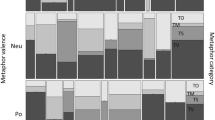Abstract
What kinds of linguistic resources do people utilize when they try to translate metaphors into a foreign language? This investigation of the perception of translatability of body-part metaphors examined the effects of the following factors: the similarity between the human body part and the metaphorical expression (e.g., “eye” in “electric eye”) in appearance and function; the frequency of the use of the metaphor in the native language; and the perceived distance between the first language and the target language. The results of a survey of American (n = 151) and Japanese (n = 116) university students showed that both Similarity in Appearance and Similarity in Function correlated positively with Translatability, while the effect of the former was stronger than the latter. Frequency correlated positively with Translatability for the Americans, although the correlation was weaker when the target language is “distant” (Japanese or Chinese) than when the target language is “close” (Spanish). Among the Japanese, Frequency did not correlate with translatability regardless of the target language.
Similar content being viewed by others
REFERENCES
Aitchison, J. (1994). Words in the mind: An introduction to the mental lexicon (2nd ed.). Cambridge, MA: Blackwell.
Andersen, E. S. (1978). Lexical universals of body-part terminology. In J. H. Greenberg, C. A. Ferguson, & E. A. Moravcsik (Eds.), Universals of human language: Vol. 3. Word structure. (pp. 335-368). Stanford, CA: Stanford University Press.
Blasko, D., & Connine, C. (1993). Effects of familiarity and aptness on metaphor processing. Journal of Experimental Psychology: Learning, Memory, and Cognition, 19, 295-308.
Broderick, V. (1991). Young children's comprehension of similarities underlying metaphor. Journal of Psycholinguistic Research, 20, 65-81.
Carroll, J. B. (Ed.). (1956). Language, thought, and reality: Selected writings of Benjamin Lee Whorf. Cambridge, MA: MIT Press.
Chomsky, N. (1965). Aspects of the theory of syntax. Cambridge, MA: MIT Press.
Chomsky, N. (1995). The minimalist program. Cambridge, MA: MIT Press.
Dale, P. N. (1986). The myth of Japanese uniqueness. New York: St. Martin's Press.
Danesi, M. (1995). The iconicity of metaphor. In M. E. Landsberg (Ed.), Syntactic iconicity and linguistic freezes: The human dimension. Berlin: Mouton de Gruyter.
Fuller, J. (1991, October). Lexical constraints on Chinese speakers' English. Paper presented at the 17th Annual Minnesota Conference on Language and Linguistics, the University of Minnesota, Minneapolis, MN.
Gass, S. M., & Selinker, L. (1994). Second language acquisition: An introductory course. Amsterdam: John Benjamins.
Gentner, D. (1988). The metaphor as structure mapping: The relational shift. Child Development, 59, 47-59.
Gibbs, R. W. (1987). Linguistic factors in children's understanding of idioms. Child Language, 14, 569-586.
Gibbs, R. W. (1991). Semantic analyzability in children's understanding of idioms. Journal of Speech and Hearing Research, 34, 613-620.
Gibbs, R. W. (1994). The poetics of mind: Figurative thought, language, and understanding. Cambridge, MA: Cambridge University Press.
Goatly, A. (1997). The language of metaphors. New York: Routledge.
Howell, D. C. (1992). Statistical methods for psychology (3rd ed.). Boston: PWS-Kent Publishing.
Johnson, M. (1987). The body in the mind: The bodily basis of meaning, imagination, and reason. Chicago: University of Chicago Press.
Kellerman, E. (1978). Giving learners a break: Native language intuitions as a source of predictions about transferability. Working Papers in Bilingualism, 15, 59-92.
Kellerman, E. (1983). Now you see it, now you don't. In Gass, S., & Selinker, L. (Eds.), Language transfer in language learning. Rowley, MA: Newbury House.
Kellerman, E. (1986). An eye for an eye: Crosslinguistic constraints on the development of the L2 lexicon. In E. Kellerman & M. Sharwood Smith (Eds.), Crosslinguistic influence in second language acquisition (pp. 35-48). New York: Pergamon Press.
Lakoff, G. (1987). Women, fire, and dangerous things: What categories reveal about the mind. Chicago: University of Chicago Press.
Lakoff, G., & Johnson, M. (1980). Metaphors we live by. Chicago: University of Chicago Press.
Meara, P. (1980). Vocabulary acquisition: A neglected aspect of language learning. Language Teaching and Linguistics: Abstracts, 221-46.
Meara, P. (1997). Towards a new approach to modelling vocabulary acquisition. In N. Schmitt & M. McCarthy (Eds.), Vocabulary: Description, acquisition, and pedagogy. Cambridge: Cambridge University Press.
Nippold, M. A., & Taylor, C. L. (1995) Idiom understanding in youth: Further examination of familiarity and transparency. Journal of Speech and Hearing Research, 38, 426-433.
Ortony, A. (1993). Metaphor and thought (2nd ed.). Cambridge, MA: Cambridge University Press.
Ouhalla, J. (1999) Introducing transformational grammar: From principles and parameters to minimalism. New York: Oxford University Press.
Petruck, M. R. L. (1995). Frame semantics and the lexicon: Nouns and verbs in the body frame. In M. Shibatani & S. Thompson (Eds.), Essays in semantics and pragmatics. Amsterdam: John Benjamin.
Popiel, S., & McRae, K. (1988). The figurative and literal senses of idioms, or all idioms are not equal. Journal of Psycholinguistic Research, 17, 475-487.
Rosch, E. (1973). Natural categories. Cognitive Psychology, 4, 328-350.
Schweigert, W. (1986). The comprehension of familiar and less familiar idioms. Journal of Psycholinguistic Research, 15, 33-45.
Schweigert, W. (1991). The muddy waters of idiom comprehension. Journal of Psycholinguistic Research, 20, 305-314.
Schweigert, W., & Moates, D. (1988). Familiar idiom comprehension. Journal of Psycholinguistic Research, 17, 281-296.
Smith, M. K., Pollio, H. R., & Pitts, M. K. (1981). Metaphor as intellectual history: Conceptual categories underlying figurative usage in American English from 1675 to 1975. Linguistics, 19, 911-935.
Stewart, E. C. (1972). American cultural patterns. Yarmouth, ME: Intercultural Press.
Vosniadou, S. (1987). Children and metaphors. Child Development, 58, 870-885.
Yu, N. (1998). The contemporary theory of metaphor: A perspective from Chinese. Amsterdam: John Benjamins.
Author information
Authors and Affiliations
Rights and permissions
About this article
Cite this article
Sakuragi, T., Fuller, J.W. Body-Part Metaphors: A Cross-Cultural Survey of the Perception of Translatability Among Americans and Japanese. J Psycholinguist Res 32, 381–395 (2003). https://doi.org/10.1023/A:1024858712238
Issue Date:
DOI: https://doi.org/10.1023/A:1024858712238




